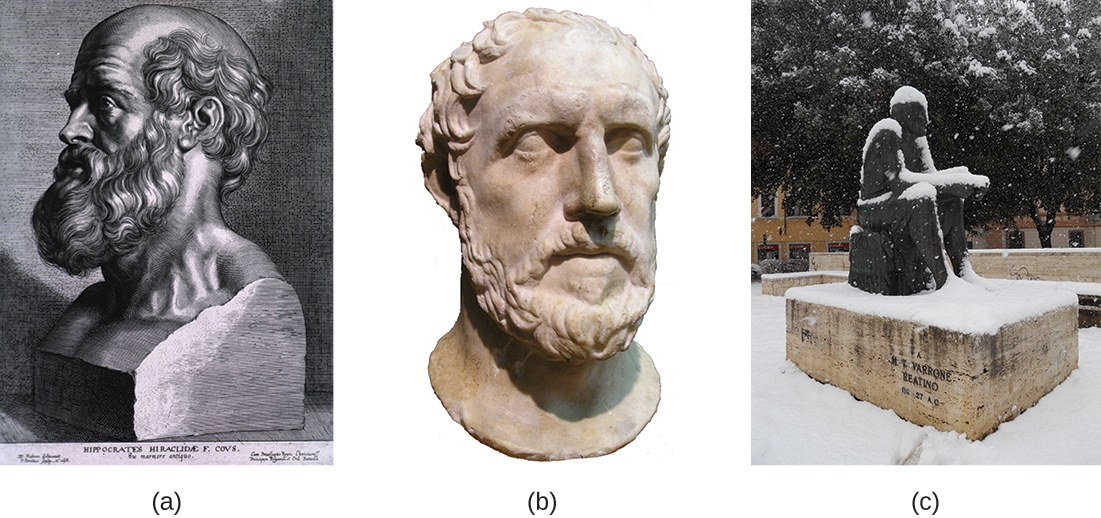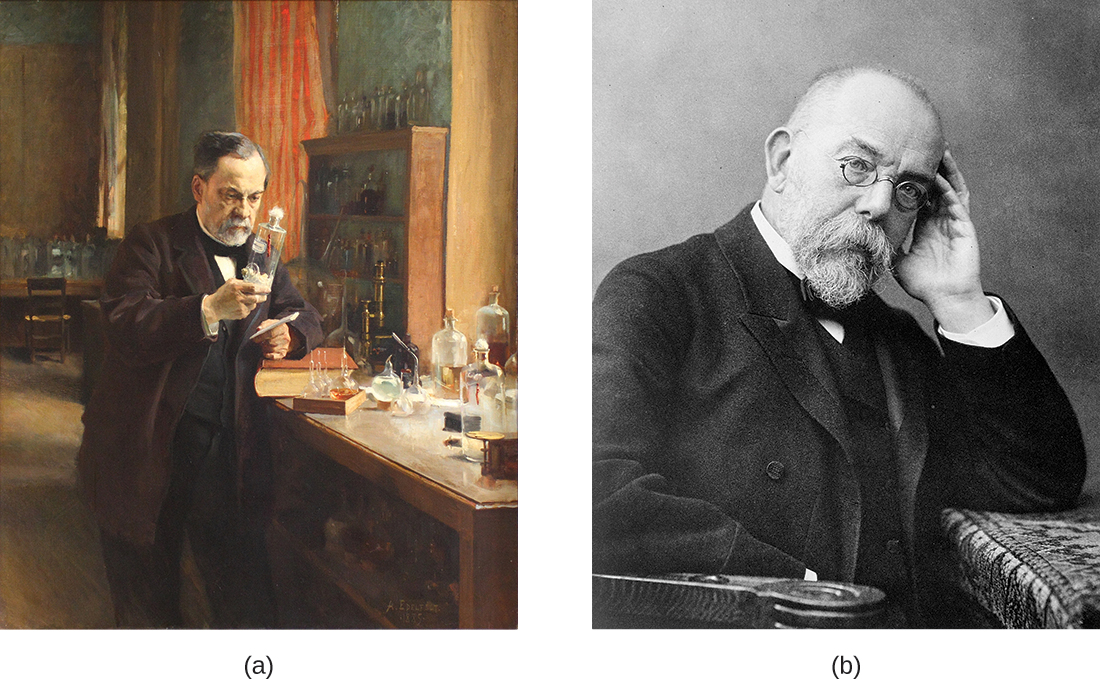1.1 – The History of Microbiology
Learning Objectives
- Describe how our ancestors improved food with the use of invisible microbes
- Describe how the causes of sickness and disease were explained in ancient times, prior to the invention of the microscope
- Describe key historical events associated with the birth of microbiology
Most people today, even those who know very little about microbiology, are familiar with the concept of microbes, or “germs,” and their role in human health. Schoolchildren learn about bacteria, viruses, and other microorganisms, and many even view specimens under a microscope. But a few hundred years ago, before the invention of the microscope, the existence of many types of microbes was impossible to prove. By definition, microorganisms, or microbes, are very small organisms; many types of microbes are too small to see without a microscope, although some parasites and fungi are visible to the naked eye.
Humans have been living with—and using—microorganisms for much longer than they have been able to see them. Historical evidence suggests that humans have had some notion of microbial life since prehistoric times and have used that knowledge to develop foods as well as prevent and treat disease. In this section, we will explore some of the historical applications of microbiology as well as the early beginnings of microbiology as a science.
Fermented Foods and Beverages
People across the world have enjoyed fermented foods and beverages like beer, wine, bread, yogurt, cheese, and pickled vegetables for all of recorded history. Discoveries from several archeological sites suggest that even prehistoric people took advantage of fermentation to preserve and enhance the taste of food. Archaeologists studying pottery jars from a Neolithic village in China found that people were making a fermented beverage from rice, honey, and fruit as early as 7000 B.C..3
Production of these foods and beverages requires microbial fermentation, a process that uses bacteria, mold, or yeast to convert sugars (carbohydrates) to alcohol, gases, and organic acids (Figure 1.3). While it is likely that people first learned about fermentation by accident—perhaps by drinking old milk that had curdled or old grape juice that had fermented—they later learned to harness the power of fermentation to make products like bread, cheese, and wine.

The Iceman Treateth
Prehistoric humans had a very limited understanding of the causes of disease, and various cultures developed different beliefs and explanations. While many believed that illness was punishment for angering the gods or was simply the result of fate, archaeological evidence suggests that prehistoric people attempted to treat illnesses and infections. One example of this is Ötzi the Iceman, a 5300-year-old mummy found frozen in the ice of the Ötzal Alps on the Austrian-Italian border in 1991. Because Ötzi was so well preserved by the ice, researchers discovered that he was infected with the eggs of the parasite Trichuris trichiura, which may have caused him to have abdominal pain and anemia. Researchers also found evidence of Borrelia burgdorferi, a bacterium that causes Lyme disease.4 Some researchers think Ötzi may have been trying to treat his infections with the woody fruit of the Piptoporus betulinus fungus, which was discovered tied to his belongings.5 This fungus has both laxative and antibiotic properties. Ötzi was also covered in tattoos that were made by cutting incisions into his skin, filling them with herbs, and then burning the herbs.6 There is speculation that this may have been another attempt to treat his health ailments.
Early Notions of Disease, Contagion, and Containment
Several ancient civilizations appear to have had some understanding that disease could be transmitted by things they could not see. This is especially evident in historical attempts to contain the spread of disease. For example, the Bible refers to the practice of quarantining people with leprosy and other diseases, suggesting that people understood that diseases could be communicable. Ironically, while leprosy is communicable, it is also a disease that progresses slowly. This means that people were likely quarantined after they had already spread the disease to others.
The ancient Greeks attributed disease to bad air, mal’aria, which they called “miasmatic odors.” They developed hygiene practices that built on this idea. The Romans also believed in the miasma hypothesis and created a complex sanitation infrastructure to deal with sewage. In Rome, they built aqueducts, which brought fresh water into the city, and a giant sewer, the Cloaca Maxima, which carried waste away and into the river Tiber (Figure 1.4). Some researchers believe that this infrastructure helped protect the Romans from epidemics of waterborne illnesses.

Even before the invention of the microscope, some doctors, philosophers, and scientists made great strides in understanding the invisible forces—what we now know as microbes—that can cause infection, disease, and death.
The Greek physician Hippocrates (460–370 B.C.) is considered the “father of Western medicine” (Figure 1.5). Unlike many of his ancestors and contemporaries, he dismissed the idea that disease was caused by supernatural forces. Instead, he posited that diseases had natural causes from within patients or their environments. Hippocrates and his heirs are believed to have written the Hippocratic Corpus, a collection of texts that make up some of the oldest surviving medical books.7 Hippocrates is also often credited as the author of the Hippocratic Oath, taken by new physicians to pledge their dedication to diagnosing and treating patients without causing harm.
While Hippocrates is considered the father of Western medicine, the Greek philosopher and historian Thucydides (460–395 B.C.) is considered the father of scientific history because he advocated for evidence-based analysis of cause-and-effect reasoning (Figure 1.5). Among his most important contributions are his observations regarding the Athenian plague that killed one-third of the population of Athens between 430 and 410 B.C.. Having survived the epidemic himself, Thucydides made the important observation that survivors did not get re-infected with the disease, even when taking care of actively sick people.8 This observation shows an early understanding of the concept of immunity.
Marcus Terentius Varro (116–27 B.C.) was a prolific Roman writer who was one of the first people to propose the concept that things we cannot see (what we now call microorganisms) can cause disease (Figure 1.5). In Res Rusticae (On Farming), published in 36 B.C., he said that “precautions must also be taken in neighborhood swamps
. . . because certain minute creatures [animalia minuta] grow there which cannot be seen by the eye, which float in the air and enter the body through the mouth and nose and there cause serious diseases.9

Check Your Understanding
- Give two examples of foods that have historically been produced by humans with the aid of microbes.
- Explain how historical understandings of disease contributed to attempts to treat and contain disease.
The Birth of Microbiology
While the ancients may have suspected the existence of invisible “minute creatures,” it wasn’t until the invention of the microscope that their existence was definitively confirmed. While it is unclear who exactly invented the microscope, a Dutch cloth merchant named Antonie van Leeuwenhoek (1632–1723) was the first to develop a lens powerful enough to view microbes. In 1675, using a simple but powerful microscope, Leeuwenhoek was able to observe single-celled organisms, which he described as “animalcules” or “wee little beasties,” swimming in a drop of rain water. From his drawings of these little organisms, we now know he was looking at bacteria and protists. (We will explore Leeuwenhoek’s contributions to microscopy further in How We See the Invisible World.)
Nearly 200 years after van Leeuwenhoek got his first glimpse of microbes, the “Golden Age of Microbiology” spawned a host of new discoveries between 1857 and 1914. Two famous microbiologists, Louis Pasteur and Robert Koch, were especially active in advancing our understanding of the unseen world of microbes (Figure 1.6). Pasteur, a French chemist, showed that individual microbial strains had unique properties and demonstrated that fermentation is caused by microorganisms. He also invented pasteurization, a process used to kill microorganisms responsible for spoilage, and developed vaccines for the treatment of diseases, including rabies, in animals and humans. Koch, a German physician, was the first to demonstrate the connection between a single, isolated microbe and a known human disease. For example, he discovered the bacteria that cause anthrax (Bacillus anthracis), cholera (Vibrio cholera), and tuberculosis (Mycobacterium tuberculosis).10 We will discuss these famous microbiologists, and others, in later chapters.

As microbiology has developed, it has allowed the broader discipline of biology to grow and flourish in previously unimagined ways. Much of what we know about human cells comes from our understanding of microbes, and many of the tools we use today to study cells and their genetics derive from work with microbes.
Check Your Understanding
- How did the discovery of microbes change human understanding of disease?
Footnotes
P.E. McGovern et al. “Fermented Beverages of Pre- and Proto-Historic China.” Proceedings of the National Academy of Sciences of the United States of America 1 no. 51 (2004):17593–17598. doi:10.1073/pnas.0407921102.
A. Keller et al. “New Insights into the Tyrolean Iceman’s Origin and Phenotype as Inferred by Whole-Genome Sequencing.” Nature Communications, 3 (2012): 698. doi:10.1038/ncomms1701.
L. Capasso. “5300 Years Ago, the Ice Man Used Natural Laxatives and Antibiotics.” The Lancet, 352 (1998) 9143: 1864. doi: 10.1016/s0140-6736(05)79939-6.
L. Capasso, L. “5300 Years Ago, the Ice Man Used Natural Laxatives and Antibiotics.” The Lancet, 352 no. 9143 (1998): 1864. doi: 10.1016/s0140-6736(05)79939-6.
G. Pappas et al. “Insights Into Infectious Disease in the Era of Hippocrates.” International Journal of Infectious Diseases 12 (2008) 4:347–350. doi: http://dx.doi.org/10.1016/j.ijid.2007.11.003.
Thucydides. The History of the Peloponnesian War. The Second Book. 431 B.C.. Translated by Richard Crawley. http://classics.mit.edu/Thucydides/pelopwar.2.second.html.
Plinio Prioreschi. A History of Medicine: Roman Medicine. Lewiston, NY: Edwin Mellen Press, 1998: p. 215.
S.M. Blevins and M.S. Bronze. “Robert Koch and the ‘Golden Age’ of Bacteriology.” International Journal of Infectious Diseases. 14 no. 9 (2010): e744-e751. doi:10.1016/j.ijid.2009.12.003.

